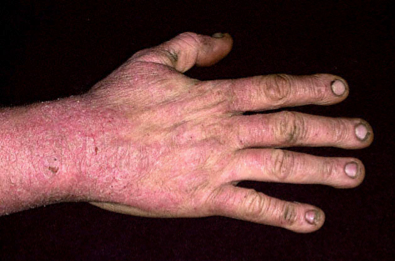Skin Conditions

Skin Conditions Farmworkers are exposed to outdoor environmental conditions, high levels of solar radiation, and repeated contact with irritant chemicals and plants. These factors put them at high risk for skin irritation and disease. Outdoor work adds additional risk of stings and bites from insects and other animals, with risk of allergic reactions. Fertilizers, pesticides, veterinary products and animal feeds, as well as feed additives may lead to skin irritation or allergic contact dermatitis. One recent study by Arcury et al., (2009), found: high levels of inflammatory skin disease (57.2%) including acne, folliculitis, and contact dermatitis; infectious skin disease (73.8%) including tinea pedis, onychomycosis, and warts; pigmentary disorders (19.1%); and trauma (34.5%). The odds of infectious skin disease increased with age. The odds of inflammatory skin disease increased with pesticide exposure and poorer housing quality.
Agricultural skin conditions fall into these major categories:
- Contact dermatitis
- Urticaria/ hives
- Dermatophyte (Tinea) infections
- Photosensitivity reactions
- Skin cancer
- Insect bite and sting reactions
Contact dermatitis: This is the most common skin problem affecting migrant farmworkers. Irritant contact dermatitis produces a non-allergic inflammatory reaction on the skin, usually within minutes. For more information, see:
Guidelines for the management of contact dermatitis: an update, J. Bourke and colleagues
Contact Dermatitis in Agriculture, by S. Sohrabian and H. Maibach.
Giant Hogweed, by NY State Dept. of Environmental Conservation.
Urticaria / hives: This is a vascular reaction in the skin associated with the release of histamine from mast cells lining blood vessels and leakage of blood plasma into the skin. It usually presents abruptly with the appearance of itchy or burning erythematous wheals, which at times have peripheral pallor. For more information, see:
Diagnosing New Onset Urticaria, by C. Bingham
Chronic Urticaria- Standard Management and Patient Education, by D. Khan, UpToDate.
Phytodermatitis: Reactions in the skin caused by plants, by Washington Dept. Labor and Industries.
Dermatophyte (Tinea) infections: These are a group of very common skin conditions that are transmitted through person-to-person contact, by fomites, by animal-person contact or by environmental exposure. Housing conditions may play an important role for many migrant workers. Infections are classified as either anthropophilic, zoophilic or geophilic. Most common cases; Tinea corporis, Tinea Manum, Tinea Barbae, and Tinea Captitis. For more information, see:
Dermatophyte (tinea) infections, by A. Goldstein and B. Goldstein, UpToDate.
Photosensitivity reactions: Photosensitivity reactions may be either phototoxic or photo-allergic in nature. In both types of photo-dermatitis a photosensitizer, such as an antibiotic, is either applied to the skin or taken systemically and when combined with ultraviolet light may produce erythema, skin tenderness, pruritis, blistering and sunburn-like reactions. Some photosensitizing agents may cause both phototoxic and photo-allergic reactions. See Photosensitivity Diagnostic Tool by Dellavalle and Callen.
Skin cancer: Skin cancer is an occupational hazard for farmworkers. There is convincing evidence that sunlight is a leading factor in the development of skin cancer. When exposure to sunlight continues over several years, the damaged skin has an increased chance of developing skin cancer. While the exact relationship is not clearly understood, it appears that the intermittent exposure, and exposure during childhood and adolescence are important predictors of basal cell carcinoma and cutaneous malignant melanoma (Oehme, F.W., 2001). High levels of sun exposure, as in farming, are also often associated with squamous cell tumors. Risk factors for skin cancer are the same as those with sun-induced problems. See Partners in Agricultural Health, Partners in Agricultural Health: agricultural skin diseases, by M. Brueggeman and E. Rosenthal (see page 9).
Insect bite and sting reactions: A variety of insects bite and sting causing inflammatory and allergic reactions, usually manifesting as pruritic lesions developing within hours or days at the site of assault. These lesions might include pruritic erythematous macules, papules, vesicles, bullae or urticarial lesions, sometimes with marked inflammation. While transmission of a systemic infection can occur as a result of an arthropod assault, the intention of these recommendations is for the treatment of local skin reactions. For more information, see:
Insect bites, general, by Burns and Adler
Lyme disease clinical guidance, by CDC, National Center for Emerging and Zoonotic Infectious Diseases, Division of Vector-Borne Diseases
West Nile Virus (WNV) Infection: Information for Clinicians, by U.S. CDC and West Nile clinical guidance, by U.S. CDC
Vector-borne diseases at glance, by U.S. CDC
Further Farmworker skin condition diagnosis and treatment links:
- Partners in Agricultural Health: agricultural skin diseases, by M. Brueggeman and E. Rosenthal
- Work-Related Skin Disorders, Risk Factors and Prevention, by M. Cohen and colleagues, Washington Dept. Labor and Industries
Farmworker prevention and education links:
- Washington State Department of Labor and Industries, Skin Health in Agricultural Workers
- Ohio State University Extension, Módulo de entrenamiento: Irritantes de la Piel
- NYCAMH:
- Lyme Disease Safety (English) and La seguridad de la Enfermedad de Lyme (Spanish)
- Protección contra el Virus del Nilo
- Poison Ivy Safety (English) and Protección contra la Hiedra Venenosa (Spanish)
Back to Common Farmworker Health Conditions and Diagnostic Tools